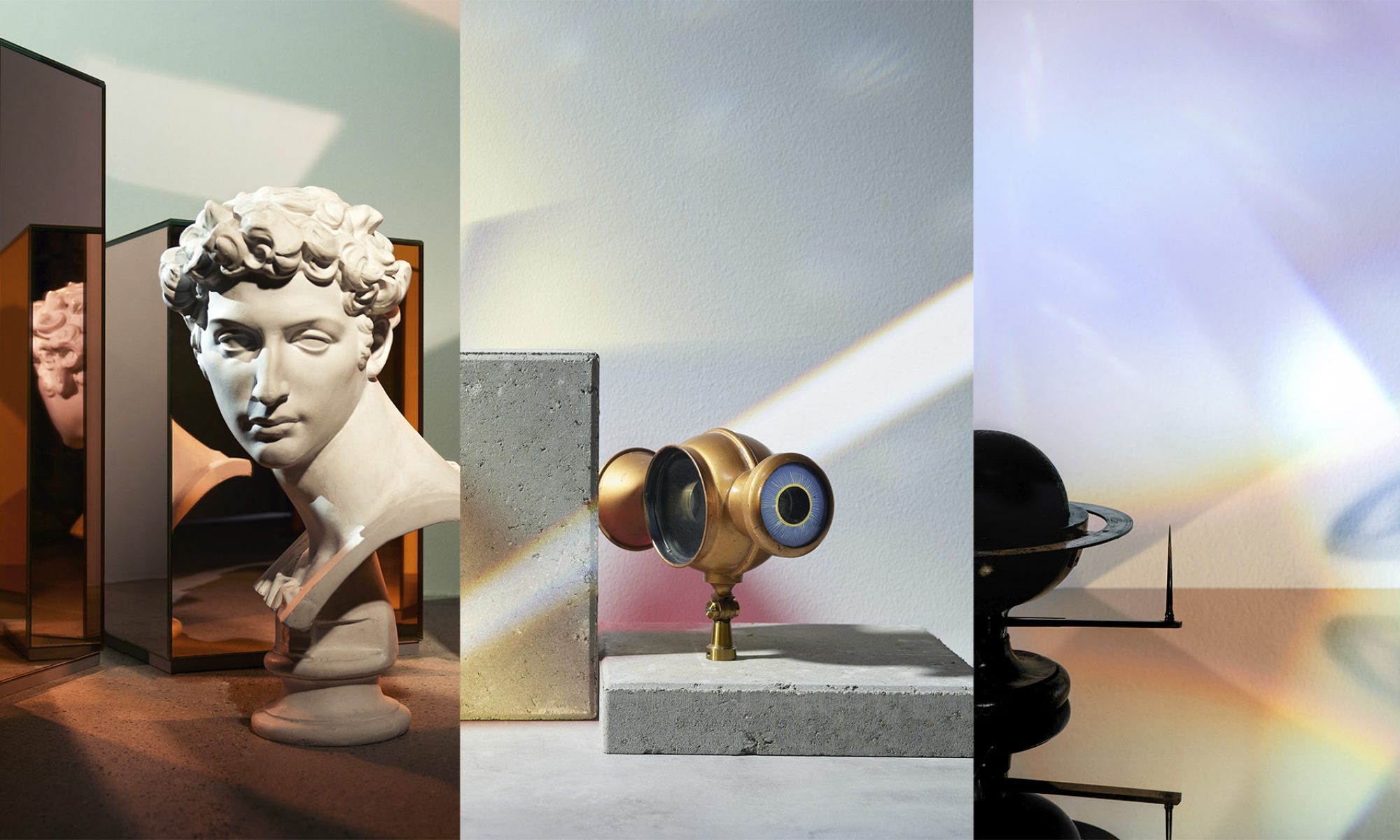This summer and autumn, the Helsinki University Museum reviewed its fascinating collection of over 2,000 chemical substances, including drugs, samples, analysis series, teaching collections and dental fillings.
To celebrate the end of this review, nicknamed the Poison Project, the object of the month in November is the liniment known as ‘Wise old woman’s ointment’, which intrigued the museum staff participating in the project. We would like to remind all readers that the drugs and recipe mentioned in this text are historical, and we do not recommend that you prepare or use them at home.
An ointment for all ailments
Viisaan muijan voide, or Wise old woman’s ointment, is a liquid medicine brushed or rubbed on skin. Liniments have been used for various ailments, such as rheumatism, sprains and burns. They were manufactured in pharmacies or on commission.
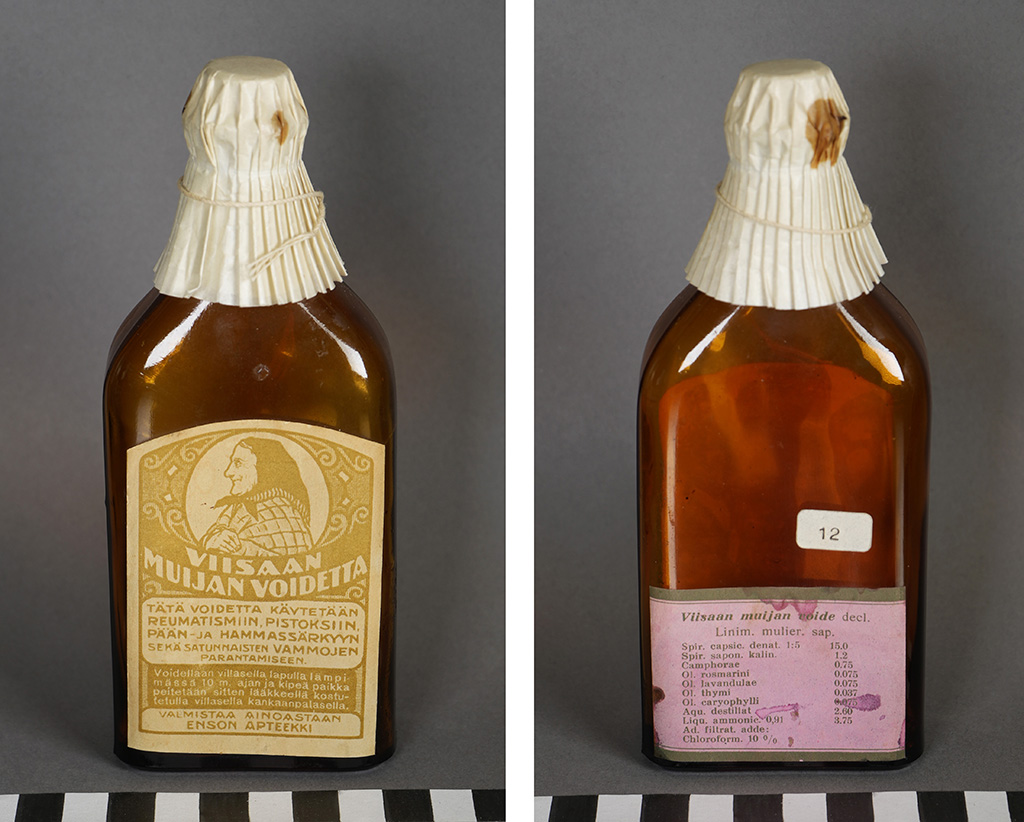
The ointment is in a brown glass bottle covered with a paper cap, with a label showing an old woman who wears a scarf on her head. The object was originally part of the collections of the museum of medical history and was purchased in the 1930s from a pharmacy in Enso (now Svetogorsk). The label indicates that the Enso pharmacy was the only manufacturer of the ointment at the time. The label and contents are original, although only traces of the ointment remain at the bottom of the bottle.
The label describes the ointment as an all-purpose medicine used for rheumatism, muscle pains, stings and pricks, headaches and toothaches, as well as accidental injuries.
According to the instructions on the side of the bottle, the liniment is for external use only. While located in a warm place, you should rub the substance on the affected area with a woollen patch for ten minutes, after which the same area should be covered with a woollen cloth moistened with the drug.
The sting of capsaicin
Liniments often contained substances that soothe or protect the skin or cause a sensation of heat. The active ingredient was frequently capsaicin, derived from chili peppers, which affected the nerve endings and produced a burning or stinging sensation. However, if swallowed, capsaicin is toxic, irritates the skin, seriously damages the eyes and may cause difficulty swallowing and breathing.
The ‘Wise old woman’s ointment’ contains, for example, a pepper or chili tincture, ethanol, camphor, potassium soap, water, ammonia and various oils, such as rosemary, lavender, thyme and clove oil.
Memorable names
In addition to the ‘Wise old woman’s ointment’, liniments used in the 20th century had other peculiar names, such as Viisaan ukon voide (‘Wise old man’s ointment’), Kyrön äijän voide (‘Old Man Kyrö’s ointment’)’, Ojan isännän linimentti (‘The Oja farmer’s liniment’), Hota-linimentti (‘Hota liniment’) and Sloan’s liniment. Today, some of these names and images may appear disrespectful.
The developer of Sloan’s liniment was Andrew Sloan, a self-taught veterinarian and horse harness maker. Originally, his liniment was used to ease muscular stiffness in horses. The liniment began to be marketed and sold for human use by Andrew’s son Earl Sawyer Sloan, and industrial manufacture commenced in the early 20th century.
In addition to the Hota liniment, a powder version of Hota, Hota-pulveri, was manufactured for pain relief by Star, a pharmaceutical factory based in Tampere, Finland. This version was also known as ‘Indian powder’ because of the Native American man pictured in the label. The powder remained popular until the 1960s.
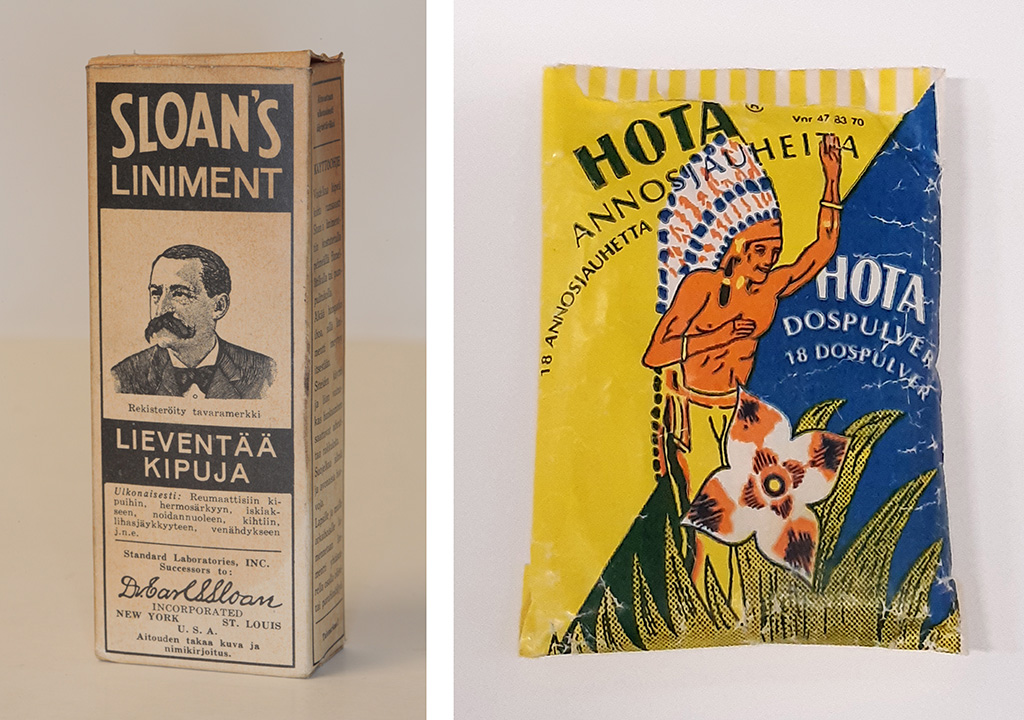
The Poison Project of 2022
Helsinki University Museum has previously explored the chemicals in its collections when they have been moved. Earlier blog posts on the topic can be read in Finnish here and here, and a Finnish-language article is also available in the Konservaattori magazine (2018).
As part of the museum’s 2019–2021 relocation, all of the museum’s chemicals were moved to the Collections and Conservation Centre of the Finnish Heritage Agency. In the new facilities, the chemicals were placed in air-conditioned cabinets, but it was soon discovered that the space was insufficient. To separate and remove safe chemicals from the air-conditioned cabinets, the substances were again reviewed.
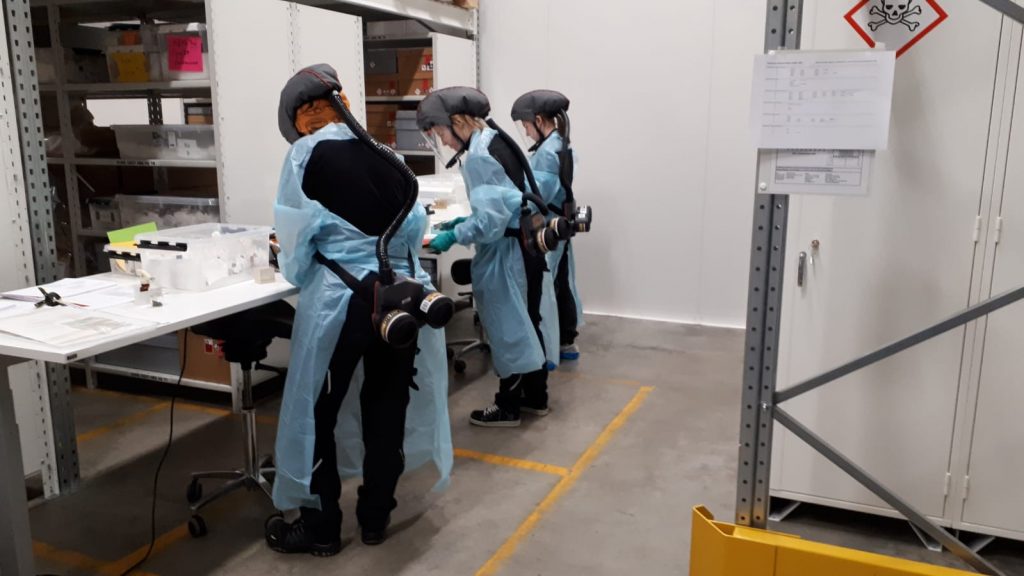
Keep calm and keep sorting
The team soon discovered that it needed chemistry expertise and, having been encouraged to cooperate with students, decided to hire Maija Montonen, a chemistry student, for the summer.
The team listed over 2,000 chemicals in a spreadsheet file for Maija to review. The chemicals were investigated with the aim of finding missing information by identifying substances, labelling hazardous chemicals and assigning CAS numbers. (CAS, or the Chemical Abstract Service, is a chemical identification system.) In addition, storage recommendations were issued, and the chemicals were colour-coded in accordance with a hazard assessment. The substances were sorted based on their properties (organic, inorganic, acidic and oxidising, flammable) and state (liquids, solids).
After being examined and sorted, the chemicals were repackaged, photographed and sealed using Parafilm. Toxins were packed in transparent plastic boxes, and an absorbent cloth was placed at the bottom of each box containing liquids to protect against possible leaks.
When handling chemicals, the team members used personal protective equipment, such as powered respirators, nitrile chemical gloves and protective aprons. A sticky mat was placed in front of doors to prevent the spread of harmful substances to other facilities. Chemicals requiring more detailed examination were handled in a fume hood.
During the review, some chemicals were disposed of. This was done if, for example, medicine packages were found to be in poor condition or too hazardous to be stored. The items disposed of included chemicals that are lethal when inhaled if the container breaks despite precautions.
Shelf life
The Helsinki University Museum is also involved in the MUHA project (Perceived and measured hazards in Finnish museum work environments). During the chemicals project, volatile solvents were measured from the packaging area using a 3M diffusion collector. The results will be published later.
Sorting, repackaging and shelving chemicals and recording information on their location was a huge task, but it resulted in a better-organised collection of chemicals and a great deal of useful information about them. The most hazardous chemicals were separated into air-conditioned cabinets to ensure safer handling.
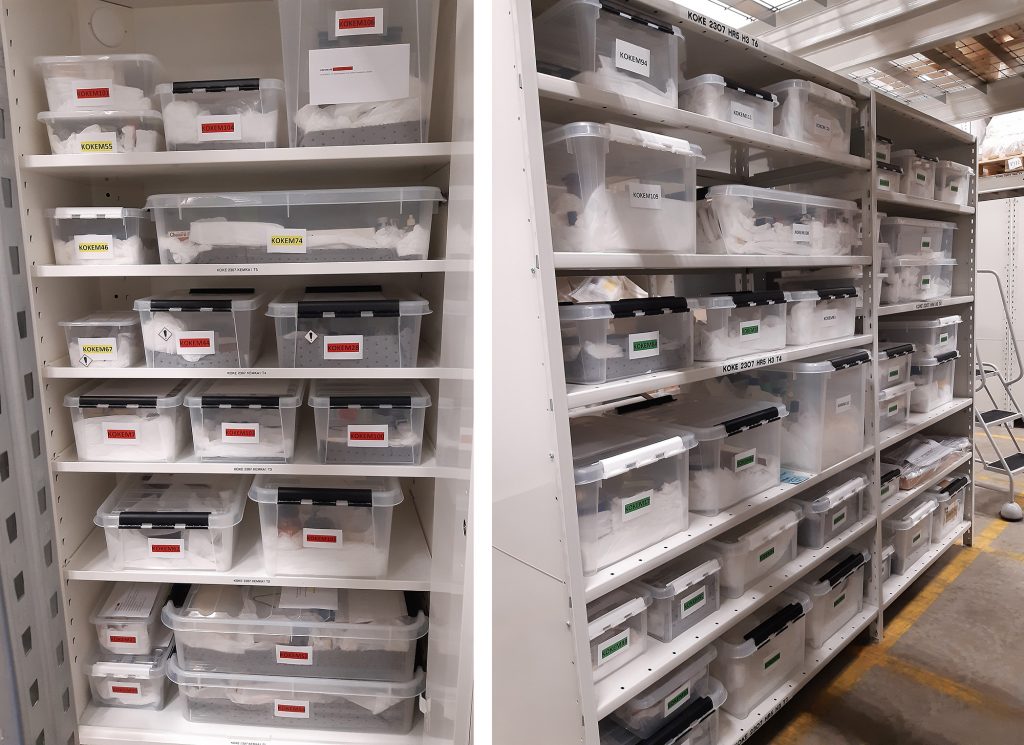
Maija’s experiences of the chemicals project:
Who are you and what are you studying?
My name is Maija Montonen and I’m a third-year student in the Bachelor’s Programme in Chemistry at the University of Helsinki.
Why were you interested in participating in this project?
The project enabled me to use the chemistry expertise I have developed through my studies, but also taught me many new things, which I’m sure will be useful in the future. This was also a unique opportunity unlikely to be repeated. The recruitment ad stated that the museum collections include a wide range of chemicals and medicines, and I was interested in exploring them in detail. I also appreciated the fact that this was a summer job that allowed me to work remotely and independently.
What did your duties involve? What are your top tips for investigating chemicals?
My duties included finding out what the chemicals contained, what their CAS numbers were and how they should best be stored. When deciding on the place of storage, I assessed the hazards involved and determined the state of the chemical and whether it was inorganic, organic, oxidising, etc.
My sources were mainly websites, such as PubChem, Sigma-Aldrich and the ILO’s International Chemical Safety Cards. Many of the chemicals were so old or unlabelled that the information available was very limited, which meant I had to do some painstaking detective work and trawl through many websites. In some cases, I conducted a hazard assessment based on another similar chemical. Various types of machine translation software were also useful because information on many of the drugs was available only in German, for instance.
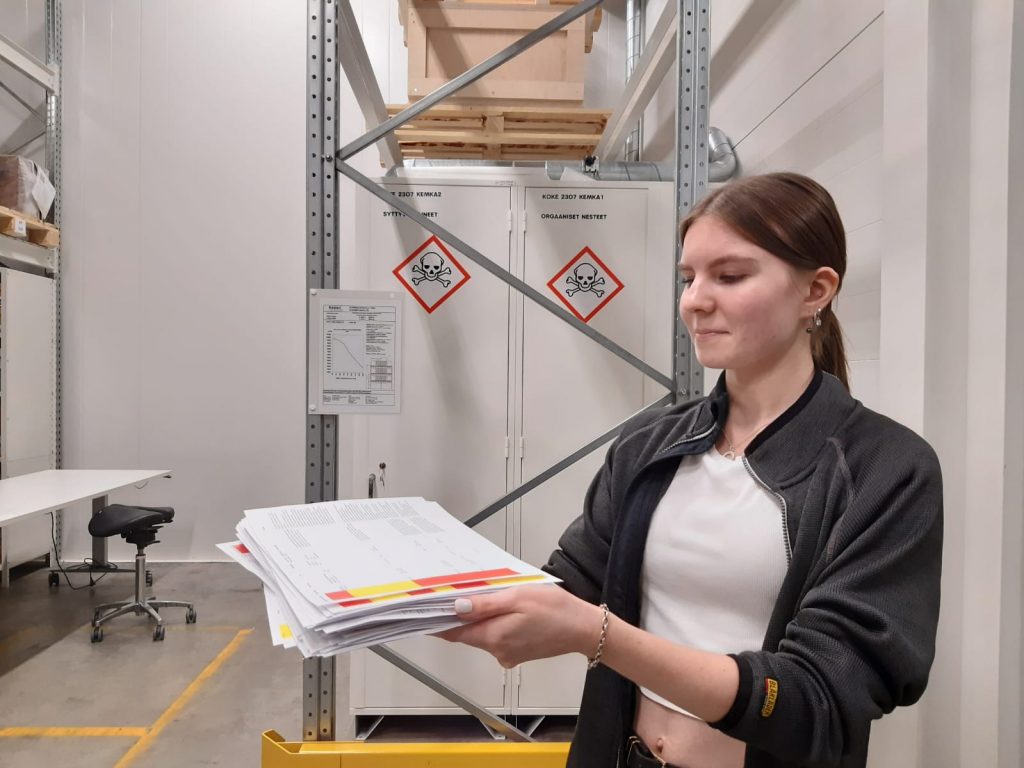
What were the biggest challenges and successes?
For many chemicals, the biggest challenge was finding reliable information on their content. I had a lot of difficulty particularly with the dental collections because the packaging and jars often indicated only the manufacturer. The collections also included some old medicines which are currently available in new versions under the same name. With them, it was difficult to determine whether the old version contained the same substances as the new ones. On the other hand, with some medicines I had information on the active ingredient, but could find no information on the properties of the substance.
When carrying out further studies, it was nice to notice that I was able to find more information on many chemicals whose properties had previously been indicated as uncertain, enabling me to determine an appropriate storage solution. I’m also happy that we were able to carry out the project pretty much on schedule, considering the size of the chemicals collection.
What was it like for a chemistry student to work at a museum?
I noticed I had a fairly limited idea of what museum staff do. It was interesting to listen to the discussions and learn more about what the staff do on a daily basis. I’ll look at exhibitions with a new perspective and appreciation.
What is your favourite chemical?
My favourites are, of course, the ones I could easily find information on 😊.
Personally, I was fascinated by the slightly more scary substances that meant the project really deserved to be called the Poison Project. Many of these were derived from plants and fungi, including the belladonna (Atropa Belladonna), the henbane (Hyoscyamus niger), the thorn apple (Datura stramonium) and ergot fungi. The group of homeopathic remedies also included interesting active ingredients, such as the monkshood (Aconitum napellus) and venom from the bushmaster (Lachesis muta) viper. Other favourites came with a story, such as the Rimpelin elixir or the poppy seed crispbreads leading to a positive drug test.
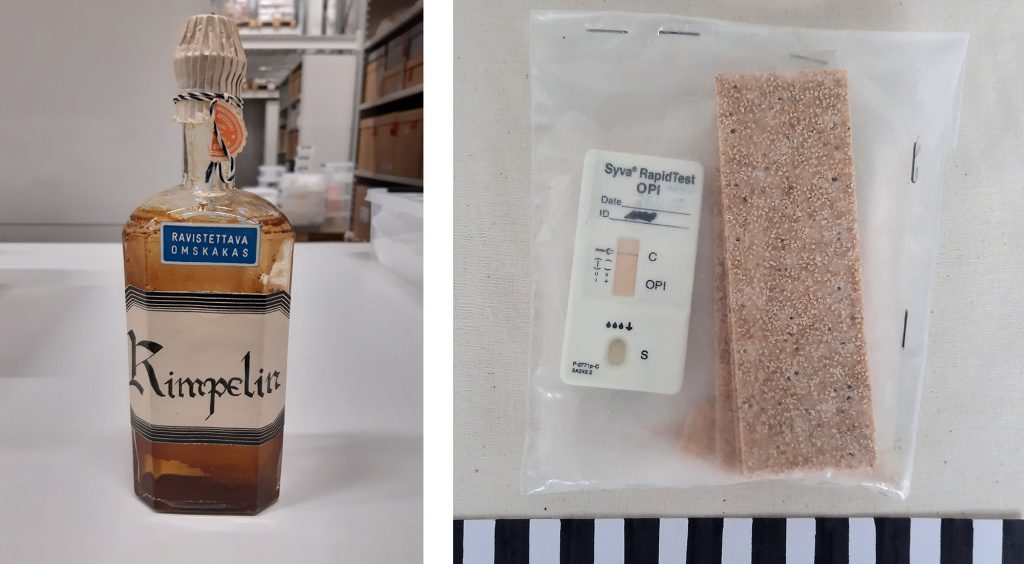
The crispbreads in the other photo have been used to teach students. If you eat the amount of poppy seed crispbreads in the bag and then take a urine sample, you will test positive for opiates.
Photos: Helsinki University Museum / Jenni Jormalainen and Henna Sinisalo.
Jenni Jormalainen
Conservator
Sources:
Bay Bottles: Sloan’s Liniment, Kills Pain. https://baybottles.com/2018/04/10/sloans-liniment-kills-pain/
Drugs.com: Sloan’s Liniment. https://www.drugs.com/mtm/sloan-s-liniment.html
Ryhmärenki: Apteekkimuseon aarteita. https://ryhmarenki.fi/wp-content/uploads/2018/02/Apteekki-museon-aarteita-Tieto-ja-kysymyskortit.pdf
Toriapteekki: Kamferitippoja, Kyrön äijää ja Viisasta muijaa. https://www.toriapteekki.fi/historia
Vahvike, ryhmä- ja viriketoiminnan aineistopankki: Apteekki: Linimentit. https://www.vahvike.fi/fi/kuvat/kuva/637
Wikipedia: Earl Sloan. https://en.wikipedia.org/wiki/Earl_Sloan
Wikipedia: Adolf Rimpiläinen. https://fi.wikipedia.org/wiki/Adolf_Rimpil%C3%A4inen
Yle, Priima: Muistatko mummon ihmerohdot. http://vintti.yle.fi/yle.fi/priima/node/403.html
